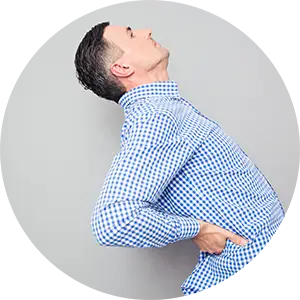Common Causes of Low Back Pain in Sun Prairie, WI
Subluxation
A subluxation is one of the most common causes of low back pain. A subluxation, or misalignment of the spine, is what chiropractors are specially trained to find and correct. A subluxation puts pressure on the nerves of the spine. This causes dysfunction of the body which presents as low back pain, sciatica, SI joint pain or numbness into the legs and feet. Specific chiropractic adjustments are the only method to removing subluxations, and chiropractors are the only doctors properly trained to correct subluxations.
Muscle Strain
Low back pain may have a muscular component as well, such as a muscle strain. Strains may feel like a dull, achy pain that intensifies with movement. This can be caused by a sudden activity (like an injury) or slowly occur over time. Repetitive motion, poor posture and weak low back muscles contribute to it.
Muscle strains usually resolve but you want to address and fix it early before it becomes a chronic pain. If you continue to have the same muscle strain flaring up over time, it can be a symptom of structural issue. The doctors at Noble Choice Chiropractic use specific examination techniques to discern if your low back pain is due to a muscular strain or spinal issue.
Bulged Lumbar Discs
The spinal disc is a cushion between each vertebrae that helps to absorb shock to the spine. The outside of the disc are formed by circular fibers while the nucleus (inside) of the disc is looser and more jelly-like.
Over time, discs can wear down and dehydrate. When this happens, the fibers begin to tear, especially following an injury or accident. If the tearing is bad enough, the nucleus starts to bulge toward the outside of the disc, putting pressure on the spinal nerves. This can cause pain that travels down your back and sometimes down the leg and foot.
Herniated Lumbar Discs
Just like with bulged discs, the outside fibers of then disc begin to tear and the nucleus moves toward outside of the disc. But if the fibers tear enough, the nucleus actually breaks through the disc and puts even more pressure on a spinal nerve. Herniated discs tend to be more painful and cause more intense leg pain.
You may have heard that some herniated discs can resolve themselves. This is due to a process called phagocytosis, where the body reabsorbs the nucleus that has bulged outside of the disc. While we try to treat herniated discs as conservatively as possible, some people may use surgery a treatment option.
Sacroiliac Joint Dysfunction (SI Joint Pain)
The sacroiliac joint is where the sacrum (tailbone) meets your pelvis. The primary function of the SI joint is to absorb shock between the upper body and the pelvis and the legs. Unlike the rest of the spine, the SI joint has little motion so when it isn’t moving properly, it can cause pain. 15-30% of all low back cases are caused by SI joint dysfunction. Some causes of Sacroiliac Joint Dysfunction include leg length discrepancy, pregnancy, and repeatedly stressing the joints.


